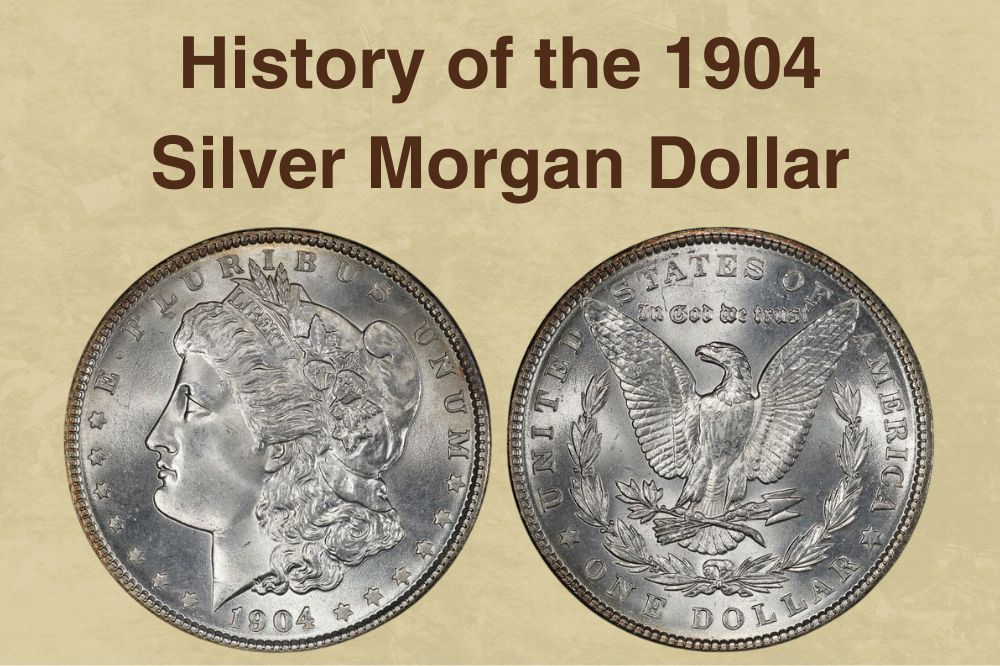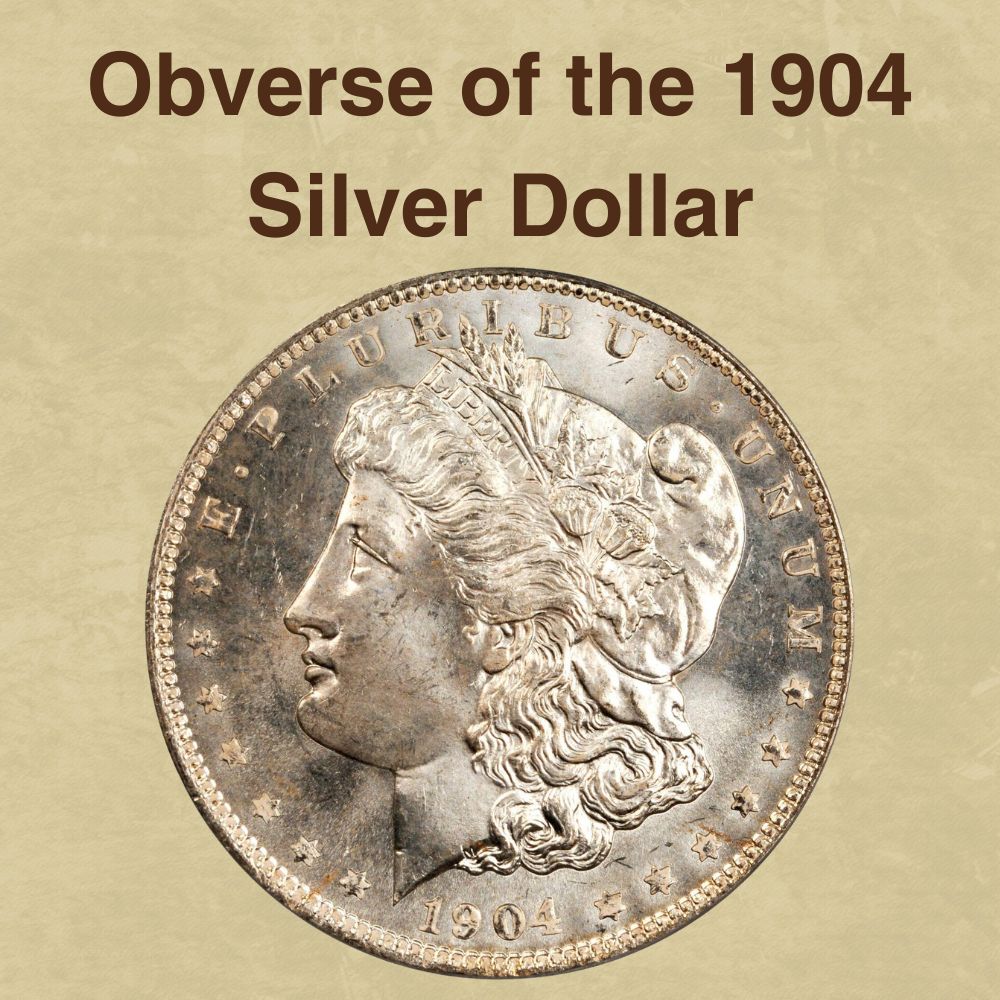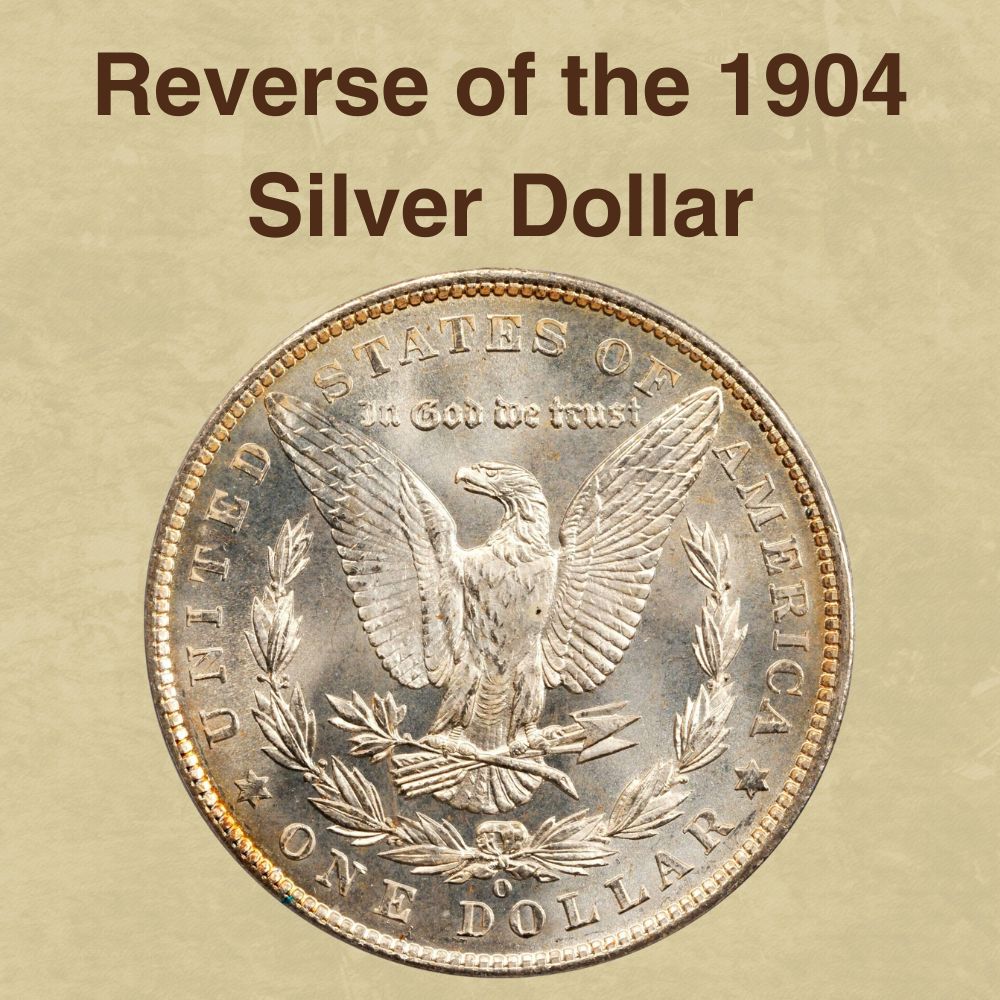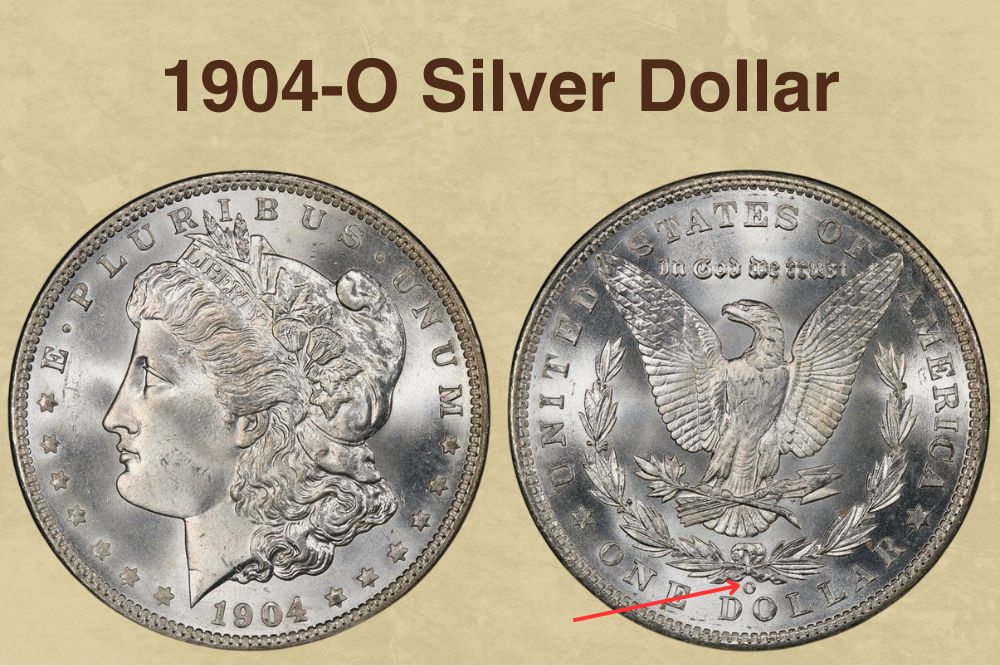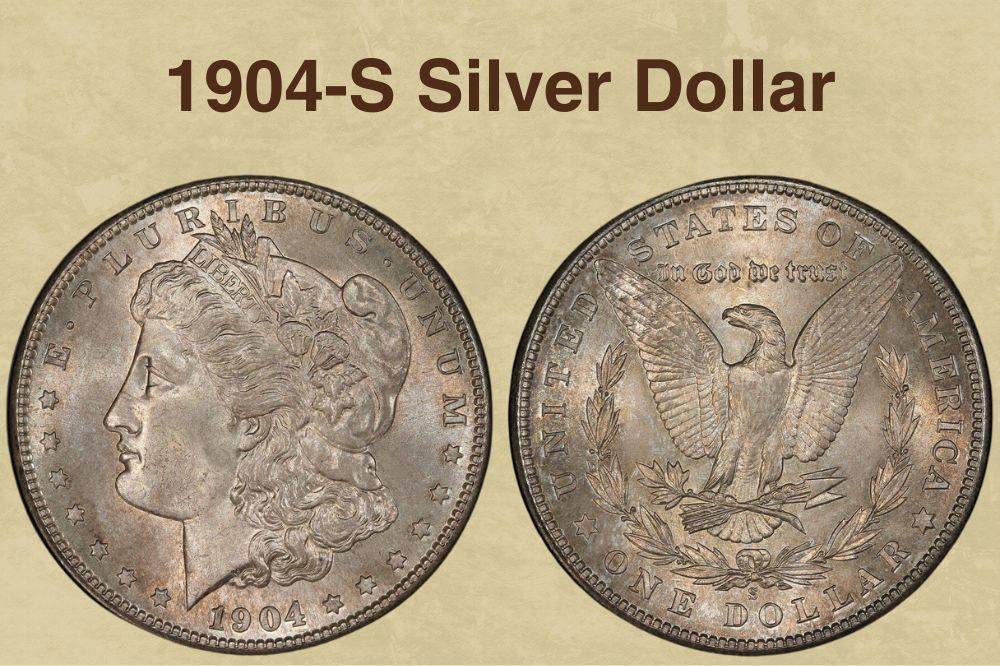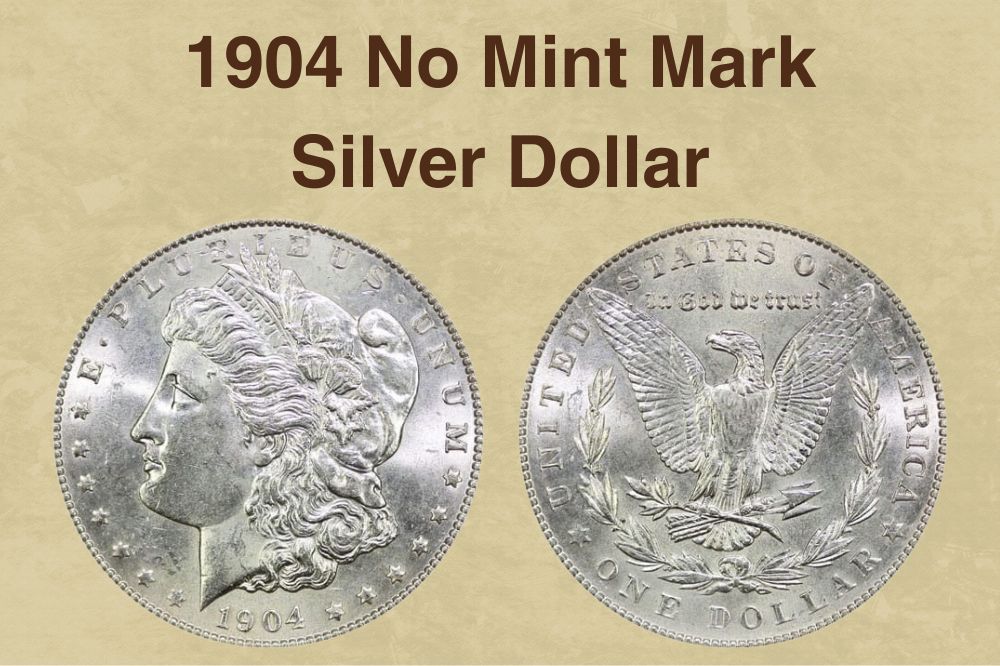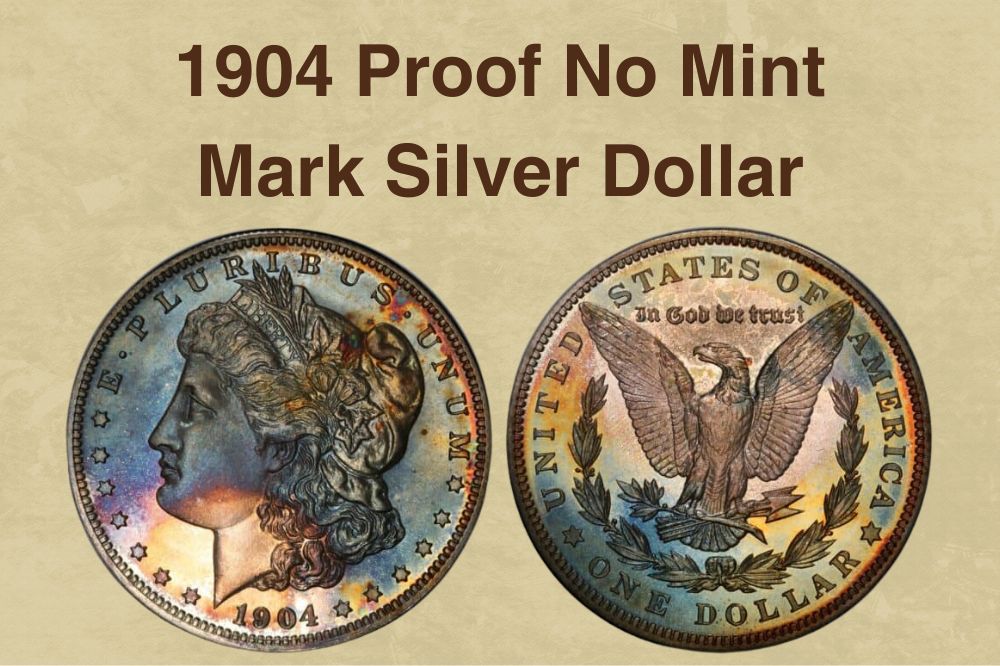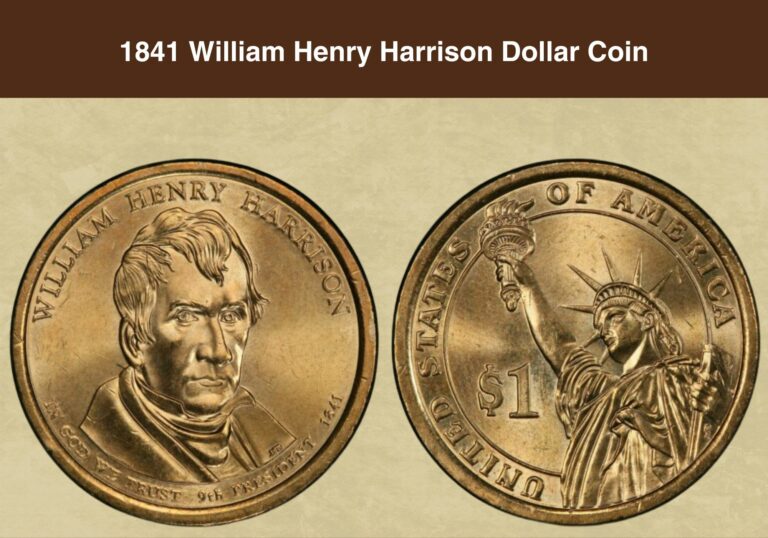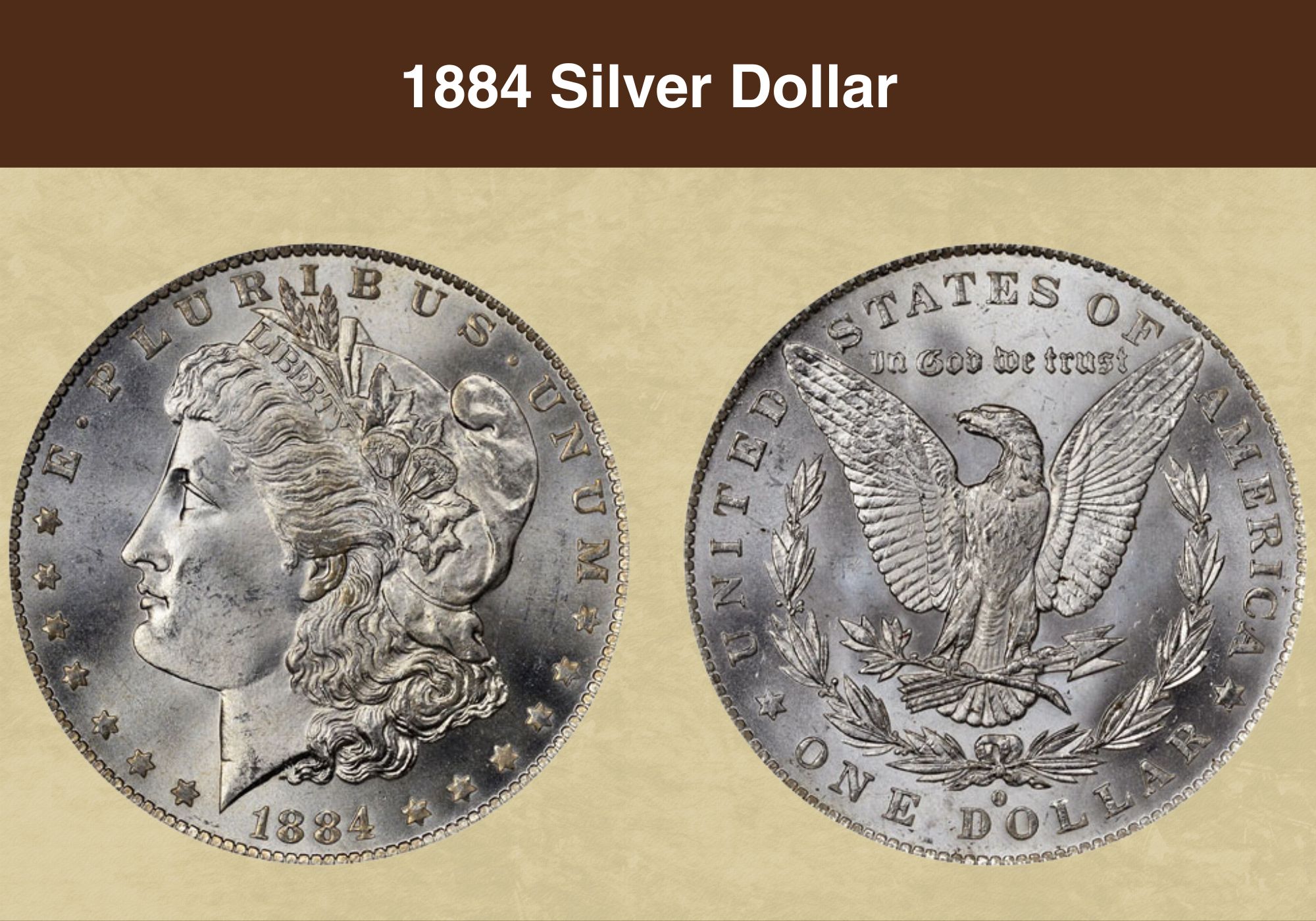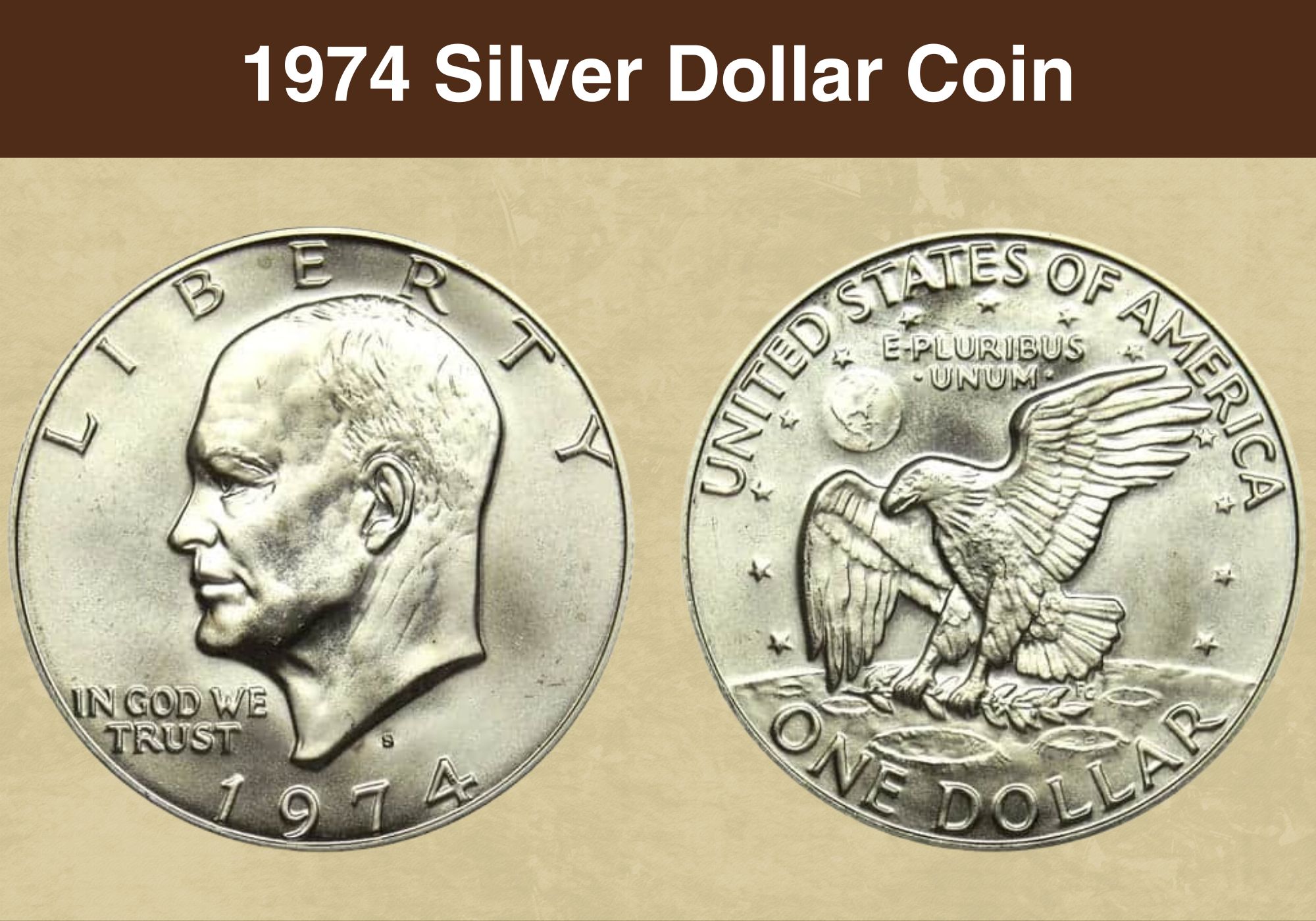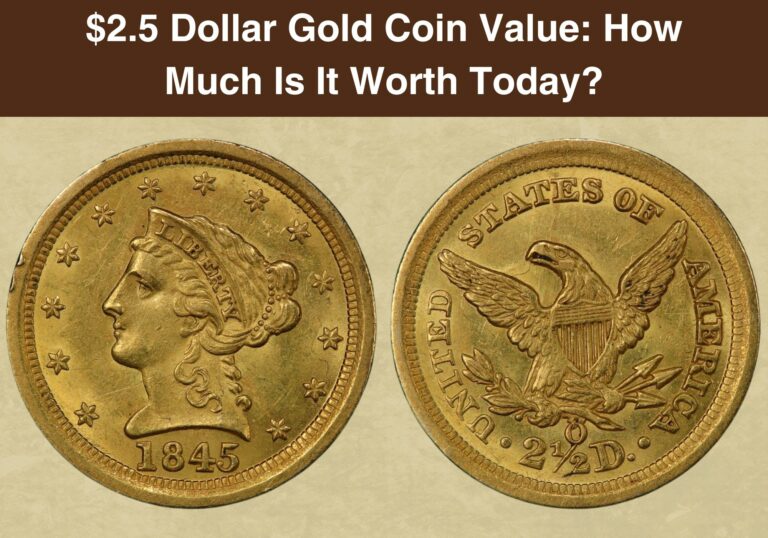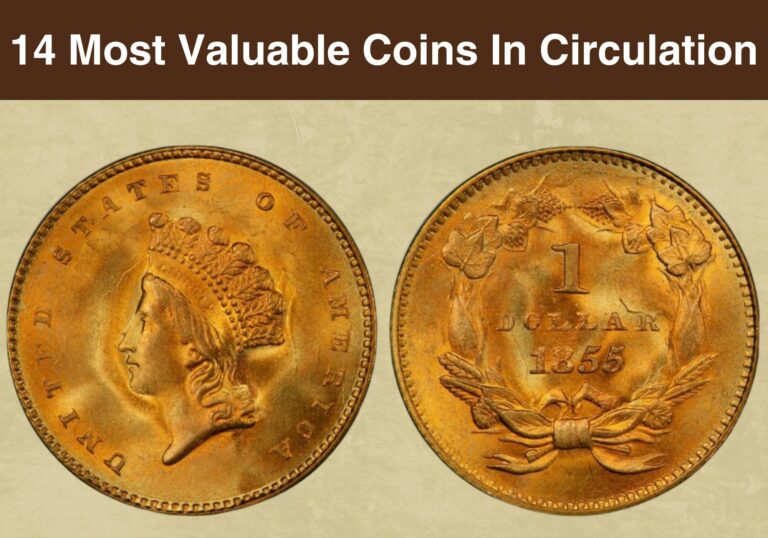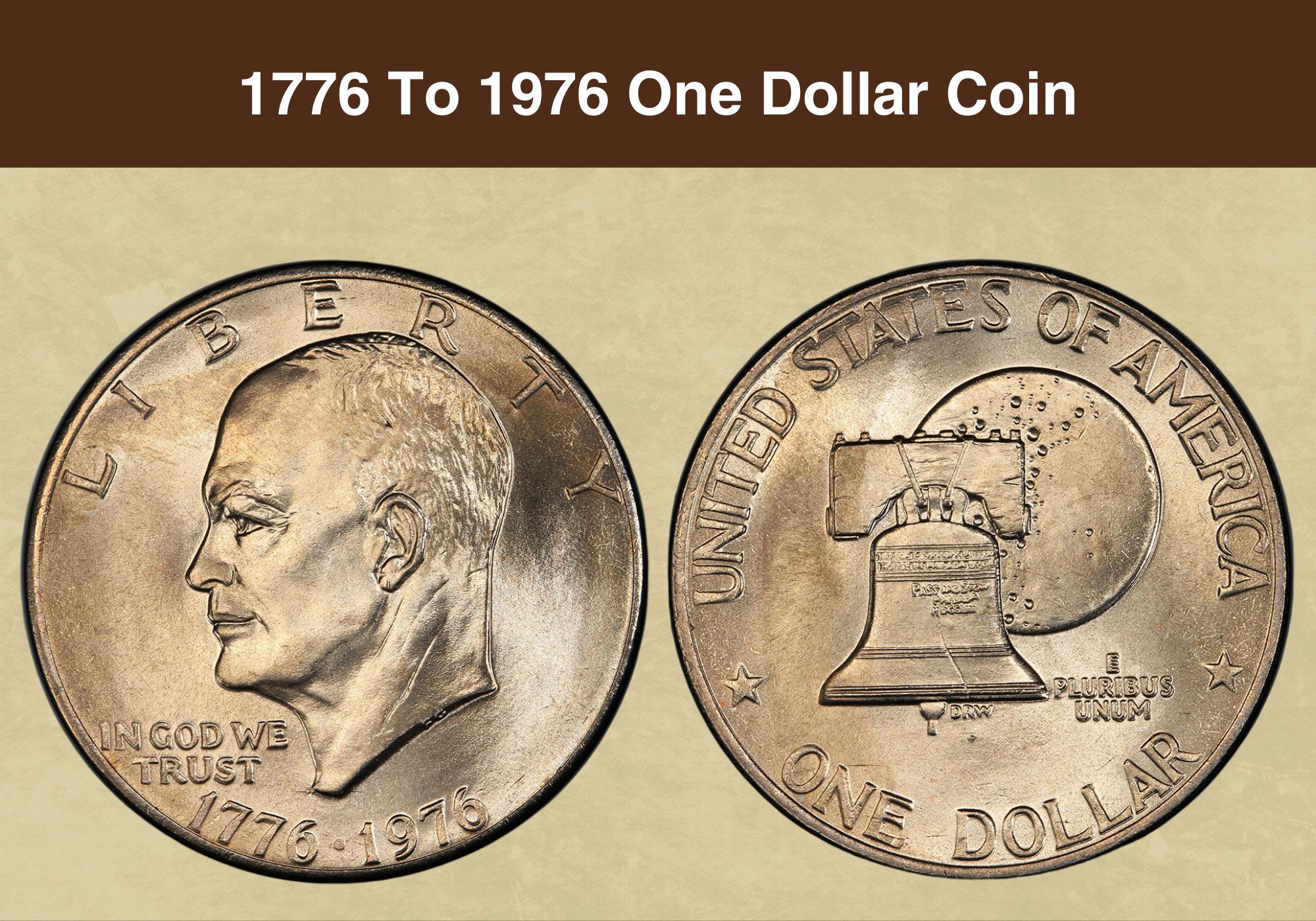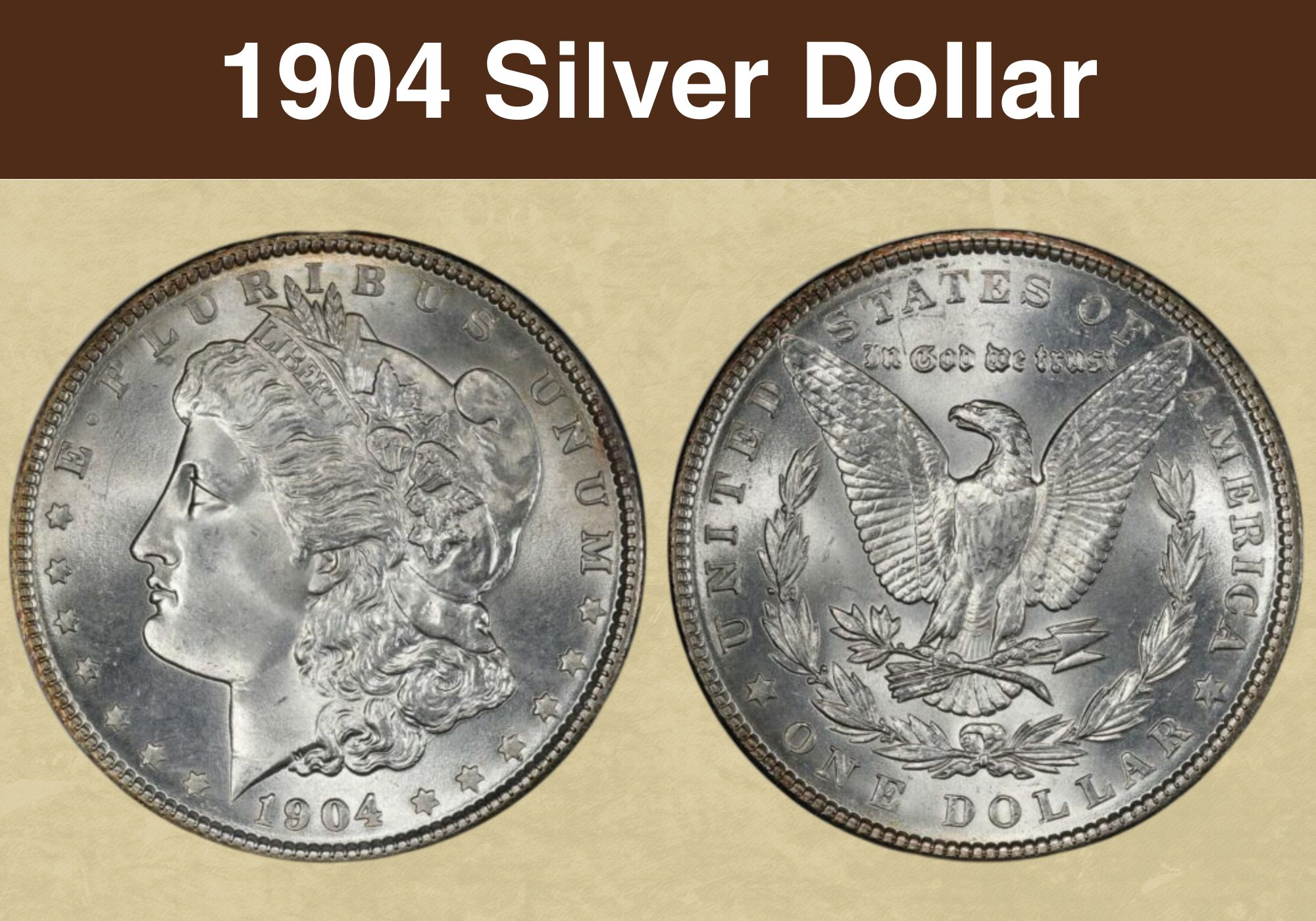
Coin Value Contents Table
- 1904 Silver Dollar Value Charts (Business Strike)
- 1904 Silver Dollar Value (Proof)
- History of the 1904 Silver Morgan Dollar
- Features of the 1904 Silver Dollar
- 1904 Silver Dollar Grading
- 1904 Silver Dollar Value Guides
- 1904-O Silver Dollar Value
- 1904-S Silver Dollar Value
- 1904 No Mint Mark Silver Dollar Value
- 1904 Proof No Mint Mark Silver Dollar Value
- Rare 1904 Silver Dollar Errors List
- Where to Sell Your 1904 Silver dollar ?
- 1904 Silver Dollar FAQ
Technically speaking, 1904 was the final year of the Morgan Silver Dollar. New batches were coined in 1921 and 2021, but they were special editions. 2021 Silver Dollars were only made in San Francisco and Philadelphia, though they had other mint marks. And 1921 was the one time they minted $1 coins in Denver. But let’s concentrate on the 1904 Silver Dollar Value.
1904 Silver Dollar Value Charts (Business Strike) |
||||||
| Coin | XF 45 | AU 55 | MS 60 | MS 63 | MS 65 | MS 67 |
| 1904-O Silver Dollar | $48 | $62 | $75 | $90 | $240 | $5,000 |
| 1904-O Silver Dollar Proof-Like | – | – | $120 | $185 | $450 | $21,000 |
| 1904-O Silver Dollar Deep-Mirror Proof-Like | – | – | $160 | $300 | $1,350 | $27,500 |
| 1904-S Silver Dollar | $650 | $2,150 | $3,300 | $6,000 | $8,500 | $87,500 |
| 1904-S Silver Dollar Proof-Like | – | – | $3,500 | $9,500 | $24,500 | – |
| 1904 No Mint Mark Silver Dollar | $70 | $90 | $150 | $525 | $1,900 | $40,000 |
| 1904 No Mint Mark Silver Dollar Proof-Like | –
|
– | $800 | $2,750 | $26,500 | – |
| 1904 No Mint Mark Silver Dollar Deep-Mirror Proof-Like | –
|
– | $2,250 | $9,000 | $70,000 | – |
1904 Silver Dollar Value (Proof) |
||||||
| Coin | PR/PF 50 | PR/PF 60 | PR/PF 65 | PR/PF 66 | PR/PF 67 | PR/PF 68 |
| 1904 Proof No Mint Mark Silver Dollar | $1,050 | $2,200 | $7,000 | $9,250 | $35,000 | $55,000 |
| 1904 Proof No Mint Mark Silver Dollar Cameo | – | – | $24,000 | $36,500 | $72,500 | – |
History of the 1904 Silver Morgan Dollar
Here in the US, the Chief Mint Engraver is in charge of coin designs. The first one was a Scotsman. And yes, his name was Scott, though he dropped one T when he moved here. The next three were born in Pennsylvania, which made sense because the US Mint was based in Philadelphia. But the 5th and 6th Chief Mint Engravers were a London-born father-and-son.
William Barber, the 5th Mint Engraver, learned his trade from his father John, then taught it to his son Charles. And since they acquired their craft in England, their style was markedly different from their predecessors on the job. Their boss seemed happy with this British style though, since in 1876, he reached out to the Royal Mint in the UK to get recommendations.
At the time, the Silver Trade Dollar was doing a lot of legwork abroad, effectively competing against foreign silver coins. But we wanted a Silver Dollar that would circulate within our borders. William Barber had designed the Trade Dollar but Henry Linderman, the Mint Director, wanted an English Assistant Engraver for this new project. So he sent to England.
How the Morgan Dollar Began
C. W. Freemantle was the Deputy Mint Master over there, and he suggested George Morgan. The plan was for him to do six months training under William Barber. He’d be working with Charles Barber (who was also an assistant at the time), but he stayed on. When William died in office, Charles took over. And later, when Charles died, George became Chief Engraver.
George T. Morgan is best known for (re)designing the Silver Morgan Dollar, the task that brought him to the US in the first place. He based his version of Lady Liberty on the profile of Anna Willess Williams, though she preferred to have her identity hidden. He wanted to bring out contemporary American features instead of the Classic Greek ones on older coins.
Willess posed for him five times as he worked on the coin. Meanwhile, Morgan studied bald eagles to inform his design for the back of the coin. Elsewhere, lobbyists were pushing the Bland-Allison Act to ensure the US Mint bought a pre-set amount of silver from miners each year. This cache was coined into Silver Dollars until the stockpiles eventually ran out in 1904.
Also read: 12 Most Valuable One-Dollar Coin Worth Money
Features of the 1904 Silver Dollar
Officially, the heads side of a coin is called its obverse while the tails side is its reverse and the thin side is its edge. This edge sometimes has ridges called reeds. The words on a coin are known as mottos or legends while the images are devices and the background is the field. A collar or rim is the raised border on a coin, and a planchet is a blank disc that makes a coin.
The Obverse of the 1904 Silver Dollar
It shows Lady Liberty wearing a Phrygian cap and a headband that says Liberty. Wheat and cotton sprigs are peeking out of her cap, though people often mistake the cotton leaves for maple. Lady Liberty is facing left. The legend E Pluribus Unum is above her head and the date is under her with 13 stars between the phrases. Her neckline cut-off has M for Morgan.
The Reverse of the 1904 Silver Dollar
It shows an eagle stretching its wings while holding three arrows and an olive branch. A laurel wreath sits under the bird from wing to wing and is tied with a ribbon in the middle. The left ribbon loops says M for Morgan and the mint mark is under the ribbon knot. The top of the coin says United States of America and In God We Trust. The bottom says One Dollar.
Other Features of the 1904 Silver Dollar
The 1904 Silver Dollar was a Morgan Dollar so it was 90% Silver, 10% Copper, and contained 412.5 grains of Fine Silver. It weighed 26.73g and in 1904, it had 189 edge reeds. The coin was 38.1mm in diameter (1.5″) and 2.4mm thick (0.09″). For reference, Morgan Dollars minted in 2021 and after 2023 were 99% Silver. Also, a few 1921 Morgan Dollars had 157 edge reeds.
Also read: 14 Most Valuable Coins In Circulation
1904 Silver Dollar Grading
Both old and new coins are graded using the Sheldon Scale from 1 to 70. This includes Morgan Dollars like this 1904 antique, which is over a hundred years old. But some Morgan Dollars have extra reflectivity, namely PL for Proof-Like and DMPL for Deep-Mirror Proof-Like. These regular strike coins are pristine enough to pass for special edition collectibles.
| # | Grade |
|---|---|
| 1 | Basal State-1 |
| 2 | Fair |
| 3 | Very Fair |
| 4, 5, 6 | Good |
| 7, 8, 10 | Very Good |
| 12, 15 | Fine |
| 20, 30 | Very Fine |
| 40 | Extremely Fine |
| 50 | About Uncirculated |
| 60 | Mint State |
| 65 | Mint State |
| 70 | Mint State |
Please check our grading guides to know your coin scale, It’s the necessary step to know the exact value of your coin.
Check out now: How to Grade Morgan Silver Dollar?
1904 Silver Dollar Value Guides
1904 Silver Morgan Dollars were coined in Philadelphia, New Orleans, and San Francisco. The latter two made business strikes or regular strikes for daily use while Philly made both proof coins and circulating currency. Different dies are used for proof coins and circulating ones, but some uncirculated business strikes look a lot like proofs (i.e. PL and DMPL coins).
You may also see Silver Dollars described as VAMs. This acronym refers to Leroy Van Allen and A. George Mallis. They made a comprehensive list of Morgan Dollar and Peace Dollar die varieties, and every VAM has cash value to traders and collectors. More than 3,000 VAMs exist, but PCGS only acknowledges 317 Morgan Dollar VAMs and 52 Peace Dollar VAMs.
1904-O Silver Dollar Value
In 1904, the New Orleans Mint made 3,720,000 Silver Morgan Dollars with the O Mint Mark. In July 2017, an MS 67 sold for $39,950. Over a hundred coins have shown up in this grade so their value in October 2023 is $5,000. But six coins have reached PCGS and been graded as MS 67+ so those are worth $43,500 in October 2023. Sadly, MS 65 is only $240.
That’s because more than 14,000 coins have been submitted in MS 65, plunging the price in the process. Proof-Like coins are a lot rarer. An MS 67 PL was $19,200 in September 2017 and since only two are known, they’re now worth $21,000. Meanwhile, an MS 66+ DMPL sold for $12,338 in 2018 and is still worth $12,000 today. An MS 67 DMPL goes for $27,500.
1904-S Silver Dollar Value
The San Francisco Mint made 2,304,000 Silver Dollars in 1904. They were all circulating coins and had the S Mint Mark. In October 2015, an MS 67 sold for $70,500. Only two are known to date, so their value rose to $87,500 in October 2023. Meanwhile, an MS 65 goes for $8,500 today because PCGS has graded more than 150 of them. And MS 60 is $3,300.
As for Proof-Like coins, an MS 66 PL sold for $30,550 in December 2013. No others have shown up so it’s now worth $45,000. An MS 60 PL goes for $3,500 and an MS 65 PL sells for $24,500 in October 2023. So far, PCGS hasn’t graded any DMPL submissions, but NGC sold two MS 64 DMPL coins in 2005. The going rate was $9,200 in January and $14,950 in May.
1904 No Mint Mark Silver Dollar Value
The Philadelphia Mint made 2,788,000 Circulating Silver Dollars without mint marks. In October 2015, an MS 66 sold for $17,625. PCGS has graded sixty of these so far, dropping their current value to $6,250. But it has also seen eleven MS 66+ coins at $13,750 and one MS 67 coin at $40,000. Notably, they’ve graded over 2,000 coins as MS 63 so they’re $525.
Let’s go to Proof-Like coins. An MS 65 sold for $19,550 in October 2005. It’s the only one that PCGS has seen, so eighteen years later, its value is up at $26,500. One step down, the fifteen MS 64 PLs are $4,250. Meanwhile, an MS 60 PL is $800 in October 2023. Up top, an MS 65 DMPL was $54,625 in July 2008. Now it’s $70,000. And an MS 60 DMPL is $2,250.
1904 Proof No Mint Mark Silver Dollar Value
In 1904, Proof Silver Dollars had mirror-like fields and frosted devices. They were made using special proof dies that had a field scrubbed with horsehair to make it extra shiny. The devices on these dies were pickled in acid to create that hazy texture. But this frosting faded a little every time the proof die struck a coin, so the first 50 to 100 coins showed high contrast.
They were graded Deep Cameo (DCAM) or Ultra Cameo. The next 50 to 100 were Cameos. In 1904, the Philadelphia Mint made 650 Proof Morgan Dollars. They were 90% Silver and had no mint marks. In December 2016, a PR 67+ sold for $34,075. It’s worth $42,500 today with four samples graded by PCGS. They also estimate their PR 68 at $55,000 in October 2023.
But even in low grades, 1904 (P) Proof Dollars are pricy because they made so few. A PR 45 is $900 in October 2023. Meanwhile, looking at cameo coins, a PR 67 CAM was $51,700 in August 2017. It was an NGC-graded coin, and they usually fetch less than PCGS coins. Today, PCGS estimates a PR 67 CAM at $72,500 even though they haven’t sold or received any yet.
Also read: Top 10 Most Valuable Morgan Silver Dollar Worth Money
Rare 1904 Silver Dollar Errors List
Although mint equipment is carefully calibrated to produce perfect coins, mint mistakes do happen. It’s why coins are inspected before they enter circulation. The goal is to pull out any errors, recycle, and correct them. But when flawed coins escape into the wild, they’re worth a lot more on the open market. Let’s look at some 1904 Silver Dollar Errors that are profitable.
1904-O Silver Dollar Planchet Lamination Error
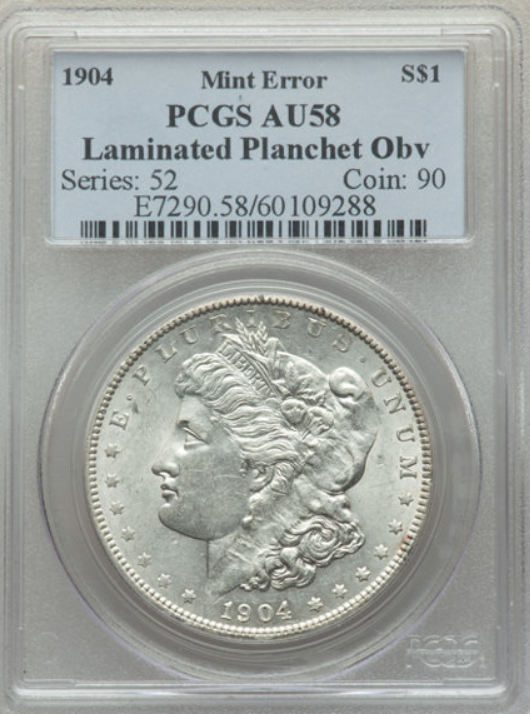
Many coins have layers of mixed metals, and as we said earlier, the Morgan Silver Dollar is 9 parts silver and one part copper. A lamination error is when one layer comes off, exposing the metal beneath. It can be a scratch, a peeled stripe, or a splotch. On this coin, there’s a lamination above ME in America, exposing the copper below. Graded MS 63, it sold for $90.
1904-O Silver Dollar Rotation Error
To make a coin, the obverse and reverse die strike the blank at the same time. The two dies are positioned at 180°. This ensures that if you flip the coin vertically, the side facing you remains upright. But on this coin, one die was positioned at about 170° so the coin appears askew when you flip it. This isn’t a graded coin, but the error still raised its price to $215.
1904 (P) and 1904-S Silver Dollar Struck Thru Errors
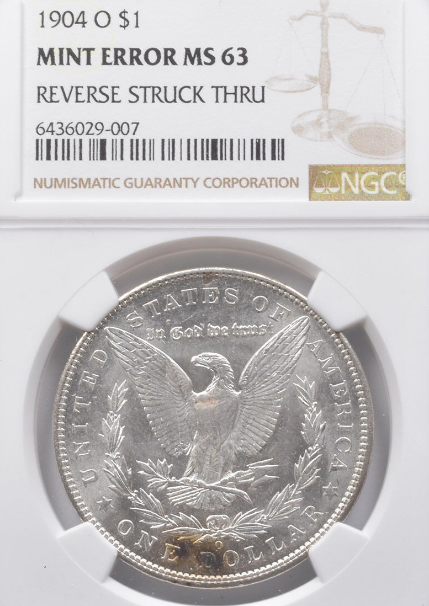
A strike-through error is when a foreign object gets between the die and the blank, leaving echoes of its existence on the coin. It could be some cloth, tape, a staple, or a metal shard. If you can identify the interloper – and especially if bits of it are still attached – then the coin is worth more. A 1904 (P) graded AU 58 was $90. A 1904-S with a bigger strike thru was $230.
Where to Sell Your 1904 Silver dollar ?
Now that you know the value of your coins, do you know where to sell those coins online easily? Don’t worry, I’ve compiled a list of these sites, including their introduction, pros, and cons.
Check out now: Best Places To Sell Coins Online (Pros & Cons)
1904 Silver Dollar FAQ
How Much Silver is in a 1904 Silver Dollar?
The 1904 Silver Dollar had 412 ½ grains of fine silver. That represented 90% Silver and it was alloyed with 10% Copper to make the metal harder, which eased the minting process. For reference, one grain is 64.9mg and gets its name from the ideal weight of edible cereals i.e. rice, corn, wheat, barley, etc. Precious metals were measured in troy ounces and grains.

